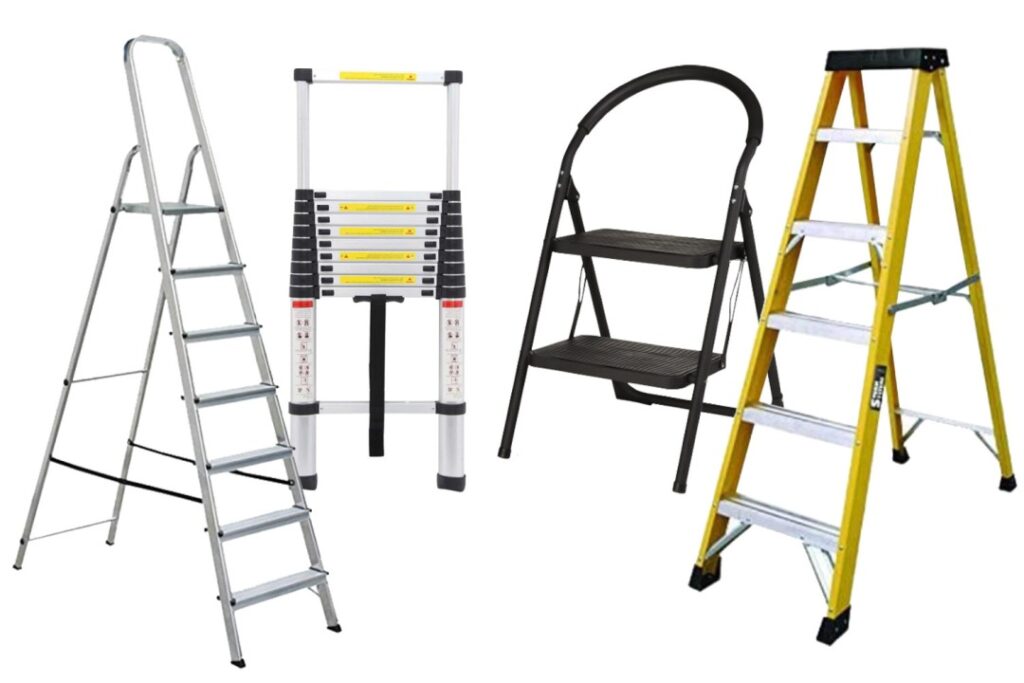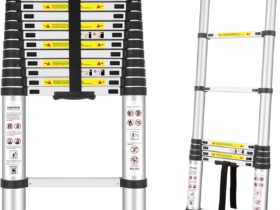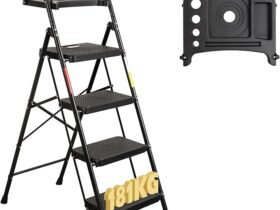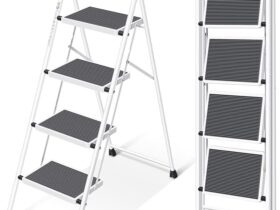Introduction
Hey there! Have you ever found yourself scratching your head in front of a bunch of ladders, not sure which one to pick? Don’t worry, we’ve got your back! Welcome to “The Ultimate Guide to Select the Right Ladders” – your go-to helper for choosing the best ladder without any stress.
Whether you’re embarking on a DIY project at home, managing a construction site, or maintaining industrial facilities, the right ladder can make all the difference in efficiency, safety, and overall success. Join us on this journey as we unravel the complexities of ladder selection and empower you to elevate your projects to new heights, quite literally.
In this comprehensive guide, we delve into the intricacies of ladder selection, providing you with the knowledge and insights needed to make informed decisions tailored to your specific needs. From understanding the different types of ladders and their respective applications to evaluating key factors such as height, applicable, weight capacity, and safety features, this guide equips you with the tools to identify the perfect ladder for any task or environment.
Elevate Your Reach: The Ultimate Guide how to choose the Right Ladders for your needs”
Based on our extensive testing and evaluations, we have identified several key factors to consider when select the top reach for your needs. Before embarking on your ladder selection journey, it’s essential to consider factors such as Duty Rating, height, equipment,Stability,Design,Effectiveness,Portability,Features,Value,
The Ultimate Guide to Selecting the Right Ladders :Determine Your Need to
Before select right ladders , it’s crucial to pinpoint your specific needs.
Consider the following questions:
- What tasks do you plan to use the ladder for?
- How frequently will you use the ladder?
- What is the maximum height requirement for your tasks?
- Will the ladder primarily be used indoors, outdoors, or a combination of both?
- Do you need a lightweight, portable ladder, or can you manage with a heavier, more stable option?

Breakdown of common ladder types and the tasks they’re
When choosing a ladder, it’s essential to match the type of ladder to the specific tasks you perform most frequently, whether they are indoors or outdoors. The right ladder ensures safety, efficiency, and convenience. Here are the various types of stairs to consider, along with their ideal uses:
Step Ladders Indoor Essential
- Description: Self-supporting and portable, with flat steps and a broad base for stability.
- Ideal For:They come in various heights and are suitable for indoor tasks such as painting walls, hanging pictures, or dusting chandeliers, cleaning, reaching shelves, changing light bulbs, and accessing overhead storage. They typically range from 4 to 8 feet in height.
- Advantages:step stairs feature a self-supporting A-frame design. Easy to store and maneuver; doesn’t need to be leaned against a wall.
Extension stairs For Hard-to-Reach Heights
- Description: Consists of two or more sections that slide to adjust the height.
- Ideal For: Outdoor tasks such as cleaning gutters, reaching high windows, or roof maintenance. They can extend from 16 to 40 feet or more.
- Advantages: Offers significant height; compact when not in use; stable when properly positioned.
Telescoping Ladders Compact and Versatile
- Description: Collapsible design that extends and locks by the foot.
- Ideal For: Both indoor and outdoor use where storage space is limited and portability is key.
- Advantages: Highly portable; easy to transport; adjustable to different heights.
Multi-Position LaddersVersatility at Its Best
- Description: Versatile ladders that can transform into various configurations such as A-frame, extension, or scaffolding.
- Ideal For: A wide range of tasks both indoors and outdoors, from home renovations to garden work.
- Advantages: Extremely versatile; can replace several different types of stairs; adjustable to various positions and heights.
Platform LaddersThe Best of Both Worlds
- Description: Similar to step ladders but with a large, stable platform at the top.
- Ideal For: Tasks that require prolonged standing at height, such as installing light fixtures or painting ceilings.
- Advantages: Provides a secure, comfortable standing area; reduces fatigue during long tasks.
Attic Ladders
- Description: Foldable stairs attached to the attic door.
- Ideal For: Accessing attic spaces or lofts.
- Advantages: Space-saving; easy to pull down and store; often includes handrails for additional safety.
Step Stools Compact and Handy
- Description: Small, lightweight ladders with one to four steps.
- Ideal For: Low-height tasks such as reaching kitchen cabinets, changing light bulbs, or accessing items on high shelves.
- Advantages: Highly portable; easy to store; perfect for quick, small tasks
Straight Ladders Simplicity Meets Practicality
- Description: They do not have a self-supporting frame and must be positioned at an angle to ensure stability.straight
- Ideal For: Straight stairsare ideal for tasks that require access to elevated areas without the need for self-supporting stability. They are commonly used for Roof Access,Exterior Painting,Window Cleaning.
- Advantages:Straightforward design with no moving parts, making them easy to use
Fire Escape Ladders
- Description: Fire escape ladders are portable, emergency-use ladders designed to provide a safe exit from a building during a fire.
- Ideal For: Emergency Evacuations, Providing a safe and fast means of escape from multi-story buildings during a fire or other emergencies when regular exits are blocked.
- Advantages: Can be folded or rolled up and stored in a small space, such as under a bed or in a closet, making them easily accessible in an emergency.
Selecting the right Ladders Material for Your Needs
Choosing the right ladder equipment.is crucial for ensuring safety, efficiency, and durability in your work. Different materials offer distinct advantages and are suitable for various applications.
Aluminum ladders are often a popular choice because they are lightweight, easy to carry, and relatively inexpensive.. But everyone knows that metal and electricity don’t mix—so when working near sources of electricity, it’s vital to avoid this material stairs. However, since this type ladders conducts electricity, it’s crucial to avoid using these stairsnear power lines or other energized equipment.
Wooden ladders, on the other hand, offer the Two benefits of wooden ladders are that wood is not a conductor of electricity and wood does not become hot or cold in ambient temperatures, making them safe for electrical work. However, it’s important to ensure that wooden stairsdo not have metal reinforcement wires that could conduct electricity.
Fiberglass ladders are heavier but they’re suitable for using electricity, and they’re also even more durable than aluminumstairs.its stand out for their durability and safety. Although heavier, they do not conduct electricity, making them suitable for electrical work. Fiberglass also does not retain outdoor temperatures like aluminum, providing a safer and more comfortable experience. Fiberglass is a great choice for a long-lasting ladder
Below is a comparison of fiberglass, aluminum, and woodstairs to help you make an informed decision.
| Material | weight | Durability | Conductivity | Weather Resistance | Popular Applications |
| Fiberglass | Heavier | Highest | Nonconductive; suitable for use around electricity | Most weather-resistant | Heavy construction |
| Aluminum | Lightest | High | Conductive; can’t be used around electricity | Corrosion-resistant | Siding, painting, and roofing |
| Wood | Medium | Durable | Nonconductive; suitable for use around electricity | Requires maintenance to prevent rot | indoor use, painting, general repairs |
Fiberglass Ladders
- Weight: Heavier compared to aluminum but provides greater stability.
- Durability: Highest durability, making it ideal for heavy-duty tasks.
- Conductivity: Nonconductive, making it safe for electrical work.
- Weather Resistance: Most weather-resistant, can withstand harsh conditions without degrading. Popular Applications: Often used in heavy construction, electrical work, and any task requiring a highly durable and stable stairs
Aluminum Ladders
- Weight: Lightest material, making it easy to carry and maneuver.
- Durability: High durability but slightly less than fiberglass.
- Conductivity: Conductive, which means it should not be used near electrical sources.
- Weather Resistance: Corrosion-resistant, making it suitable for outdoor use. Popular Applications: Commonly used for siding, painting, roofing, and general household tasks due to its lightweight and weather resistance.
Wood Ladders
- Weight: Medium weight, offering a good balance between portability and stability.
- Durability: Durable but requires regular maintenance to prevent rot and decay.
- Conductivity: Nonconductive, suitable for electrical work.
- Weather Resistance: Requires maintenance; not as weather-resistant as fiberglass or aluminum.
- Popular Applications: Ideal for indoor use, painting, and general repairs. Preferred for its traditional look and solid feel.
“Choosing the Right Ladders Material: Matching to Task and Environment”
When selecting the right ladder stuff, consider the specific needs of your tasks and the environment in which you will be using the stairs
- For electrical work and heavy construction, fiberglass is the best choice due to its non conductive properties and high durability.
- For tasks that require frequent movement or outdoor use, aluminum is ideal because of its lightweight and corrosion-resistant nature.
- For indoor tasks and general repairs, wood offers a sturdy, nonconductive option but requires more maintenance to ensure longevity.
By understanding the strengths and limitations of each equipment, you can choose the ladder that best fits your needs, ensuring safety and efficiency in your work.Overall, selecting the right stairs material involves considering the specific requirements of your tasks and the working environment to ensure both safety and functionality.
” Duty Ratings: Understanding and Selecting the Right Ladders for Your Needs”
When it comes to using ladders safely and effectively, understanding ladder duty ratings is essential. stair are designed for specific weight capacities and usage scenarios, and using the wrong type of stairs for a task can result in accidents and injuries. Here’s a breakdown of ladder duty ratings and how to select the right ladder for your needs:
- Type IAA (Extra Heavy Duty Industrial): These ladders are built for the most demanding tasks, such as industrial construction and heavy-duty maintenance. They have a maximum weight capacity of 375 pounds and are constructed with robust equipment like fiberglass or alminum.
- Type IA (Heavy Duty Industrial): Type IA ladders are suitable for heavy-duty industrial use, including construction, maintenance, and professional applications. They typically have a weight capacity of 300 pounds and offer sturdy construction for stability and safety.
- Type I (Heavy Duty): This category includes ladders designed for heavy-duty commercial and industrial use, with a weight capacity of 250 pounds. They are suitable for tasks like painting, electrical work, and general maintenance.
- Type II (Medium Duty): Type II ladders are designed for light commercial use and home improvement tasks. With a weight capacity of 225 pounds, they are suitable for tasks like painting, cleaning gutters, and light construction work.
- Type III (Light Duty): These ladders are intended for light-duty household use and have a weight capacity of 200 pounds. They are suitable for tasks like changing light bulbs, accessing low-height shelves, and minor repairs around the house
Duty Ratings chart

Features of Ladders: Guide to select right ladders
Ladders are essential tools in various industries and households, providing access to heights and spaces that are otherwise difficult to reach. When selecting a ladder, it’s crucial to consider its features to ensure safety, efficiency, and suitability for the intended task. Here are some key features to look for:
1. Material Composition:
- Ladders are commonly made from aluminum, fiberglass, or wood. Each equipment offers different advantages in terms of weight, durability, and conductivity.
- Aluminum stairs are lightweight and resistant to corrosion, making them ideal for outdoor use.
- Fiberglass stairs are non-conductive, making them safer for electrical work.
- Woodstairsare sturdy and provide excellent traction, but they are heavier and may not be suitable for all environments.
2. Weight Capacity:
- Every ladder has a maximum weight capacity that should not be exceeded to ensure safety.
- Consider the combined weight of the user, tools, and applicable when selecting a ladder.
- Choose a stairs with a weight capacity that comfortably accommodates the intended load.
3. Height and Reach:
- Ladders come in various heights, ranging from small step ladders to tall extension stairs.
- Consider the maximum reachable height needed for the task at hand.
- Extension ladders offer adjustable height, providing versatility for different projects.
4. Design and Configuration:
- Ladders are available in different designs, including step ladders, extension ladders, platform ladders, and combination stairs.
- Choose a design that suits the specific requirements of the job, whether it involves climbing, standing, or working at various heights.
- Look for features such as stabilizing feet, spreader bars, and handrails for added safety and convenience.
5. Portability and Storage:
- Portability is essential for transporting the ladder to different work sites or storing it when not in use.
- Consider the size and weight of the stairs when collapsed or folded for storage or transportation.
- Some ladders feature compact designs or telescoping mechanisms for easy storage in confined spaces.
6. Versatility and Multi-functionality:
- Some ladders offer multi-functional capabilities, allowing them to be used in various configurations for different tasks.
- Consider whether the ladder can be adjusted for use on uneven surfaces, as a scaffold, or as a stairway stairs for added versatility.
7. Warranty and Durability:
- Check the warranty and ensure that the ladder is built to last, with high-quality construction and durable applicable
- Invest in a reputable brand known for producing reliable and long-lasting stairs
- Proper maintenance and care can extend the lifespan of the ladder and ensure continued safety and performance.
Ladder Safety Features: Ensuring Stability and Security
Ladders are invaluable tools for reaching heights in various settings, but they can also pose risks if not used properly. Incorporating safety features into ladder design is essential to mitigate these risks and ensure the well-being of users. Here are some crucial safety features to look for when selecting a stairs
1. Non-Slip Feet:
Non-slip feet, also known as rubberized or anti-skid feet, provide traction and stability on a variety of surfaces, including hardwood floors, concrete, and grass. These feet grip the ground securely, preventing the ladder from sliding or shifting during use.
2. Locking Mechanisms:
Locking mechanisms ensure that the ladder remains securely in place while in use, minimizing the risk of accidental collapse. Look for features such as automatic locking hinges or spreader bars that lock into position when the stairs is fully extended.
3. Wide Steps or Rungs:
Wide steps or rungs provide a stable platform for climbing and standing, reducing the risk of slips and falls. These steps offer ample space for the user’s feet and help distribute weight evenly, enhancing stability and comfort during use.
4. Stabilizing Bars or Outriggers:
Some ladders come equipped with stabilizing bars or outriggers that extend outward from the base, increasing the ladder’s footprint and improving stability. These bars provide additional support and help prevent the stairs from tipping over sideways, especially when working at height.
5. Integrated Tool Trays:
Integrated tool trays or holders allow users to keep essential tools and type within reach while working on the ladder. This feature eliminates the need to climb up and down repeatedly to retrieve tools, reducing the risk of accidents and improving efficiency.
6. High-Visibility Markings:
High-visibility markings, such as bright colors or reflective tape, increase the stairss visibility in low-light conditions or high-traffic areas. These markings serve as a visual cue to alert others to the presence of the ladder, reducing the risk of accidental collisions or tripping hazards.
7. Anti-Slip Treads:
Anti-slip treads on ladder steps or rungs provide added grip and traction, reducing the likelihood of slips and falls, especially in wet or slippery conditions. These treads typically feature textured surfaces or rubberized coatings to enhance traction and stability.
8. Safety Labels and Instructions:
Clear safety labels and instructions should be prominently displayed on the ladder to provide users with essential information on proper usage, weight limits, and safety precautions. These labels serve as a reminder of best practices and help ensure that the stairs is used safely and effectively.
9. ANSI or OSHA Compliance:
Ensuring that a ladder complies with industry safety standards set forth by organizations like the American National Standards Institute (ANSI) or the Occupational Safety and Health Administration (OSHA) is paramount.stairs meeting ANSI or OSHA standards have undergone rigorous testing and adhere to specific safety criteria, including load capacity, construction materials, and design features. Compliance with these standards provides users with assurance regarding the ladder’s quality, durability, and safety performance, minimizing the risk of accidents and injuries during use.
10. Adjustable Height:
Ladders with adjustable height options offer versatility and adaptability to various tasks and environments. Whether it’s telescoping or multi-position ladders, the ability to adjust the height allows users to customize the stairsto suit their specific needs while maintaining stability and security.
11. Weight Capacity Rating:
Every ladder comes with a specified weight capacity rating, indicating the maximum load it can safely support. It’s essential to choose a ladder with a weight capacity that accommodates the user’s weight along with any additional equipment or applicable they may be carrying. Exceeding the weight capacity can compromise the stairs stability and pose significant safety risks.
12. Impact-Resistant Construction:
Ladders constructed from impact-resistant applicable, such as reinforced fiberglass or high-strength aluminum, offer durability and resilience against accidental impacts or collisions. This feature ensures that the ladder maintains its structural integrity, even in demanding work environments, reducing the risk of collapse or failure during use.
13. Easy-to-Use Locking and Unlocking Mechanisms:
While locking mechanisms are crucial for securing the ladder in place during use, it’s equally important that they are user-friendly and easy to operate. Intuitive locking and unlocking mechanisms streamline the process of extending, retracting, and adjusting the ladder, minimizing the risk of user error and ensuring secure positioning at all times.
Bonus Ladder Safety Tips
Ensuring safety when working at heights is paramount, especially when using ladders, which are commonplace in various industries. Despite the seemingly straightforward task of ascending and descending a ladder, it’s crucial to recognize that falls are frequent and can result in severe injuries for workers.
To mitigate these risks, clear safety protocols must be in place to prevent accidents. Common causes of ladder accidents include loss of
- Stability,
- slipping due to inadequate footwear,
- dirty or wet steps,
- loose components,
- and objects falling onto workers.
Without stringent safety policies, workers may suffer from
- Bruises,
- Fractures,
- head trauma,
- internal injuries,
- and various sprains or dislocations.
To prevent accidents, it’s imperative to standardize safety procedures for working at heights, particularly when using industrial ladders. These procedures should encompass preparations before, during, and after work:
Pre-Use Checks: Inspect the stairs for any damages or wear before every use. Look for cracks, loose parts, or bent rungs.
Setup: Place the ladder on a stable, level surface. For extension ladders, ensure a secure angle by following the 1:4 rule (for every four feet in height, the base should be one foot away from the wall).
Safe Ascent and Descent: Always face the ladder when ascending or descending. Maintain three points of contact (two hands and one foot, or two feet and one hand) at all times.
Avoid Overreaching: Keep your body centred between the sides of the ladder. Do not lean out to the sides to prevent tipping.
Before work:
- Prepare applicable and select the appropriate stairs type.
- Choose and use appropriate personal fall protection equipment.
- Inspect the ladder thoroughly, referencing its documentation for maintenance and any known issues.
- Identify and assess potential risks in the work area.
- Fill out necessary permits and mark hazardous zones.
- Suspend work if weather or external conditions pose risks.
During work:
- Adhere to ladder usage instructions.
- Always wear personal protective equipment and use fall protection gear.
- Report any unidentified risk conditions.
- Restrict access to hazardous areas.
- Halt activities if unforeseen risks arise.
After work:
- Remove safety barriers.
- Dismantle and store the stairs appropriately.
- Clean the work area to prevent slips or falls.







Leave a Reply
View Comments